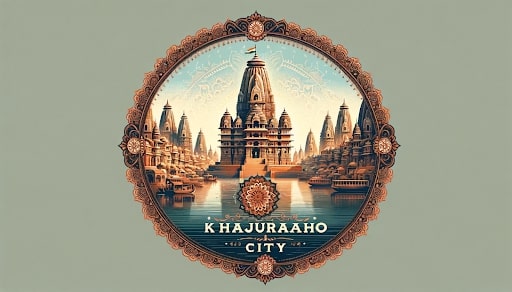
Introduction to Khajuraho City
Khajuraho is a small town with a big reputation. Nestled in the heart of India, this place is famous for its ancient temples. It’s not just any tourist spot; it’s a UNESCO World Heritage Site. That’s a big deal because it means the whole world agrees these temples are precious and need to be looked after.
Geographical Location
Khajuraho sits in the Chhatarpur district of Madhya Pradesh. It’s like a hidden gem in the wilds of central India. Getting there is an adventure. You can fly into its own airport, catch a train to the nearby station, or hop on a bus that winds through the scenic views.
|
How to Get There |
Mode of Transport |
Details |
|
By Air |
Khajuraho Airport |
Flights connect Khajuraho with major cities like Delhi. The airport is just a few kilometers from the city center. |
|
By Train |
Khajuraho Railway Station |
Trains are available from major cities. The journey shows off India’s beautiful countryside. |
|
By Road |
Bus or Car |
Roads connect Khajuraho with many places. The drive is long but full of interesting sights. |
Historical Significance
Long ago, the Chandela dynasty decided to make something spectacular. They built these temples between 950 and 1050 AD. Imagine, over a thousand years ago, people were creating these masterpieces without any modern tools! Then, they were forgotten until a British guy named T.S. Burt stumbled upon them in the 19th century. Since then, they’ve become stars of history.
The Khajuraho Group of Monuments
The temples are split into groups, but they all share a common thread: incredible carvings and sculptures. Some are pretty spicy, showing that people back then were open about human relationships. The Nagara-style architecture is like a signature of these temples, making them stand out with their beehive-shaped towers.
Cultural Heritage
These temples are like history books in stone. They show us how people lived, loved, and worshipped over a millennium ago. Hindus and Jains shared this space, proving that different beliefs can exist side by side peacefully.
Architecture and Design
Every temple was built with a plan. They used a system called Vastu-Purusha-Mandala, which is like an ancient blueprint for building sacred spaces. The designs are deep, with layers of meaning, showing how the universe works according to Hindu beliefs.
|
Temple Design |
Element |
Significance |
|
Temple Layout |
Vastu-Purusha-Mandala |
This design is a cosmic diagram that reflects the Hindu way of life. Each part of the temple represents a part of the human experience and the universe. |
The Temples Today
The Khajuraho temples have seen a thousand sunrises and as many full moons. They’re old, but not forgotten. People from all over the world come to see them. India takes care of these treasures, making sure they’ll last for more sunrises to come. One temple, the Matangeshvara, is still used for worship. It’s a living piece of history where the past meets the present.
Tourism and Economy
Tourists flock to Khajuraho, and they bring their wallets with them. This helps the town a lot. There are guides, shops, and hotels because when people visit, they need places to sleep and things to buy. This tourism money helps keep the town running.
|
Tourism Impact |
Service |
Details |
|
Economic Boost |
Hotels, Shops, Restaurants |
Tourists staying in Khajuraho help the economy. They sleep in hotels, eat in restaurants, and buy souvenirs. This creates jobs and supports local families. |
Modern Khajuraho
Today’s Khajuraho isn’t just about old stones. It’s a living town with schools, hospitals, and banks. People live their daily lives here, go to work, study, and play. It’s a mix of the ancient and the modern, where history is always present.
|
Infrastructure |
Facility |
Details |
|
Education |
Schools and Colleges |
Kids go to school here, and there are colleges too. Education is important for the town’s future. |
|
Healthcare |
Hospitals and Clinics |
When people get sick, they have hospitals and clinics to take care of them. |
|
Banking |
Banks |
Banks help people save money and support businesses. They’re important for the town’s growth. |
Agriculture and Natural Resources
Khajuraho is surrounded by nature. Farms spread out around the town. People grow grains, pulses, and spices. They use the land to feed their families and to sell crops. It’s not just about the temples; it’s about the earth and what it gives.
Cultural Activities
The town is famous for its dance festival. Once a year, dancers and musicians fill the town with color and sound. It’s a celebration of art that brings everyone together.
|
Cultural Event |
Activity |
Details |
|
Dance Festival |
Performances |
The Khajuraho Dance Festival showcases Indian classical dance forms. It’s a week-long event that attracts performers and audiences from across the globe. |
Conclusion
Khajuraho is a place where history is alive. It’s not stuck in the past; it’s moving forward, growing, and changing. The temples remind us where we come from, but the people and their lives show us where we’re going. It’s a town that respects its roots while looking ahead to the future.
FAQs
Banks(3) of Khajuraho City
| Bank name | IFSC code | Address | District | State |
|---|---|---|---|---|
| Canara Bank | CNRB0001186 | NEAR BUS STAND, KHAJURAHO , DIST CHHATARPUR (M P) - 471606 | Chhattarpur | MADHYA PRADESH |
| Central Bank of India | CBIN0284521 | CENTRAL BANK OF INDIA, OPP TO SHIVSAGAR LAKE, MAIN MARKET, KHAJURAHO 471606, CHATARPUR, MADHYA PRADESH | Chhatarpur | MADHYA PRADESH |
| State Bank of India | SBIN0002863 | CHHATARPUR, MADHYA PRADESH, PIN 471606 | Chhattarpur | MADHYA PRADESH |